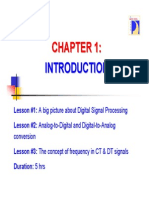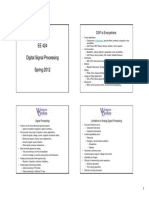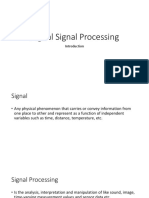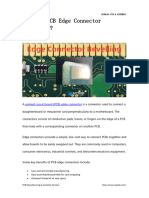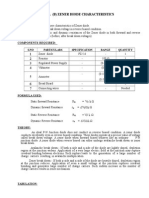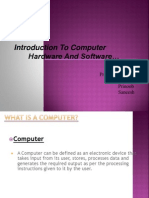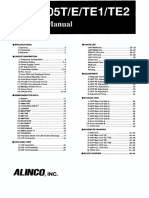Introduction
ADC
ES MUET
�Course Description
Title of Subject :
Disciplines :
Term :
Effective :
Pre-requisites : Assessment :
Sessional Work: 20%
Marks : Theory: 100
Credit Hours : 4
Minimum Contact
Hours : 52
ADC
Analog & Digital Communication
Electronic Engineering
(6th Term)
09ES-Batch and onwards
Co-requisite: Written Examination: 80%
Practical: 50
2
26
ES MUET
�Sessional Work
?? Quizzes
?? Assignments
2 Class tests
(Aims & objectives of this course + recommended
books available on the website:
http://www.muet.edu.pk/departments/electronicsengineering/course-outline)
ADC
ES MUET
�About me
Khuhed Memon
(Lecturer Dept of ES MUET)
MS Signal Processing (Nanyang Technological
University, Singapore)
BE Electronics (Pakistan Navy Engineering
College, National University of Sciences &
Technology, Pakistan)
ADC
ES MUET
�Class style
Interactive:
Discussions + questions in class, email,
office..
ADC
ES MUET
�Contact Info:
Office: OIC Basic Electronics Lab
E-mail: khuhedkk@hotmail.com
*best way to communicate : e-mail
ADC
ES MUET
�Enjoy the course
ADC
ES MUET
�This lecture
Concept of Signal Processing
Introduction to Signals
Classification of Signals
Basic elements of SP System
Analog to Digital Conversion
Sampling
Quantization
Nyquist Theorem
Applications of Signal Processing
ADC
ES MUET
�Signal Processing
Representation, transformation,
manipulation of signals and the information
they contain.
Classification:
Depends upon the type of signal to be
processed.
Analog Signal Processing
Digital Signal Processing
ADC
ES MUET
�Signal Processing
Analog SP
Continuous time signals are processed.
Digital SP
Discrete - time discrete - valued signals
processed by digital computers or other data
processing machines.
ADC
ES MUET
10
�Signal??
Any indication / information
A change in which some information is
residing
ADC
ES MUET
11
�Classification of Signals
Continuous-time / Discrete-time Signals
Continuous-valued / Discrete-valued
Signals
Deterministic / Random Signals
One-dimensional / Multi-dimensional
Signals
ADC
ES MUET
12
�Fundamental SP system
Most signals Analog in nature.
Analog to Digital Converter is used as an
interface between analog signal and Digital
Signal Processor.
Analog
Analog
Input Signal
A/D Converter
ADC
Digital Signal
Processor
ES MUET
Output Signal
D/A Converter
13
�A-D Conversion
1. Sampling
First step in going from analog to digital.
In signal processing, sampling is the
reduction of a continuous signal to a
discrete signal. A common example is the
conversion of a sound wave (a continuoustime signal) to a sequence of samples (a
discrete-time signal).
ADC
ES MUET
14
�Sampling
ADC
ES MUET
15
�ADC
ES MUET
16
�ADC
ES MUET
17
�Nyquist Theorem
In order the samples represent correctly the
analog signal, the sampling frequency must
be greater than twice the maximum
frequency of the analog signal:
fs2FM
The limiting frequency 2FM is called
Nyquist rate.
ADC
ES MUET
18
�Aliasing (Time Domain)
ADC
ES MUET
19
�Aliasing (Frequency Domain)
ADC
ES MUET
20
�Methods of avoiding Aliasing
To avoid aliasing, there are two approaches:
One is to raise the sampling frequency to satisfy
the sampling theorem.
The other is to filter off the unnecessary highfrequency components from the continuous-time
signal. We limit the signal frequency by an
effective low-pass filter, called anti-aliasing
prefilter, so that the highest frequency left in the
signal is less than half of the intended sampling
rate.
ADC
ES MUET
21
�General DSP System
ADC
ES MUET
22
�Quantization
Slide 143 CCN module 2
MIT OCW
ADC
ES MUET
23
�Companding or Non-linear
Encoding
Companding = compressing + expanding
Why companding?
Quantization levels not evenly spaced
Reduces overall signal distortion
Can also be done by companding
ADC
ES MUET
24
�ADC
ES MUET
25
�ADC
ES MUET
26
�ADC
ES MUET
27
�ADC
ES MUET
28
�Applications of SP
RADAR
SONAR
Medical
Image Processing
Pattern recognition
Edge detection
Audio Signal Processing
Speech generation
Speech recognition
Speaker identification
Telecommunications
Multiplexing
Compression
Echo control
ADC
ES MUET
29




















